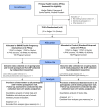SMARThealth Pregnancy: Feasibility and Acceptability of a Complex Intervention for High-Risk Pregnant Women in Rural India: Protocol for a Pilot Cluster Randomised Controlled Trial
- PMID: 34816187
- PMCID: PMC8594020
- DOI: 10.3389/fgwh.2021.620759
SMARThealth Pregnancy: Feasibility and Acceptability of a Complex Intervention for High-Risk Pregnant Women in Rural India: Protocol for a Pilot Cluster Randomised Controlled Trial
Abstract
Introduction: India is in the process of a major epidemiological transition towards non-communicable diseases. Cardiovascular disease (CVD) is the leading cause of death in women in India. Predisposing independent risk factors include pregnancy-related conditions, e.g., hypertensive disorders of pregnancy (HDP) and gestational diabetes (GDM) - also associated with significant perinatal mortality and morbidity. Early identification, referral and management of pregnant women at increased risk of future CVD may offer opportunities for prevention. In rural India, Community Health Workers (CHWs) provide most antenatal and postnatal care. Innovative solutions are required to address integrated care for rural women during transitions between antenatal, postnatal and general health services. The George Institute's SMARThealth Programme has shown that CHWs in rural India screening non-pregnant adults for cardiovascular risk, using a decision support system, is feasible. Building on this, we developed a targeted training programme for CHWs and a complex system-level intervention that uses mobile clinical decision support for CHWs and primary care doctors to screen high-risk pregnant women. In addition to addressing HDP and GDM, the intervention also screens for anaemia in pregnancy. Methods/Design: A pilot study will be undertaken in two diverse rural districts of India: Jhajjar (Haryana) and Guntur (Andhra Pradesh). Two Primary Health Centre clusters will be randomised to intervention or control groups at each study site. The primary objective of this pilot study is to explore the feasibility and acceptability of the SMARThealth Pregnancy intervention. Secondary objectives are to estimate: (a) prevalence rates of moderate to severe anaemia, HDPs and GDM at the study sites; (b) referral and follow-up rates, and (c) mean haemoglobin and blood pressure values at the routine 6 week postnatal visit. A process evaluation will be conducted to explore the acceptability of the SMARThealth Pregnancy intervention for pregnant women and healthcare workers using qualitative methods. Discussion: It is anticipated that the findings of this pilot study will help determine the feasibility and acceptability of the SMARThealth Pregnancy intervention, and highlight how the intervention might be further developed for evaluation in a larger, cluster randomised controlled trial. Clinical Trial Registration: www.ClinicalTrials.gov, identifier: NCT03968952.
Keywords: anaemia in pregnancy; cardiometabolic disorders; gestational diabetes; high-risk pregnancy; hypertensive disorders of pregnancy; pre-eclampsia.
Copyright © 2021 Nagraj, Kennedy, Jha, Norton, Hinton, Billot, Rajan, Arora, Praveen and Hirst.
Conflict of interest statement
The authors declare that the research was conducted in the absence of any commercial or financial relationships that could be construed as a potential conflict of interest.
Figures
References
-
- Norton R, Peters S, Jha V, Kennedy S, Woodward M. Women's Health: A New Global Agenda. Oxford Martin Policy Paper. Available online at: https://www.oxfordmartin.ox.ac.uk/downloads/briefings/women%27s-health.pdf (accessed February 07, 2019).
-
- Prabhakaran D, Jeemon P, Sharma M, Roth GA, Johnson C, Harikrishnan S, et al. . The changing patterns of cardiovascular diseases and their risk factors in the states of India: the global burden of disease study 1990–2016. Lancet Global Health. (2018) 6:E1339–51. 10.1016/S2214-109X(18)30407-8 - DOI - PMC - PubMed
-
- The World Bank Data 2019. Available online at: https://data.worldbank.org/indicator/SP.RUR.TOTL.ZS?locations=IN (accessed October 16, 2020).
-
- Bellamy L, Casas JP, Hingorani AD, Williams DJ. Pre-eclampsia and risk of cardiovascular disease and cancer in later life: systematic review and meta-analysis. BMJ. (2007) 335:974. 10.1136/bmj.39335.385301.BE - DOI - PMC - PubMed
Associated data
Grants and funding
LinkOut - more resources
Full Text Sources
Medical



